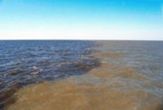Gulf Dead Zone Starts Earlier, May Grow Larger

An annual dead zone in the Gulf of Mexico has appeared earlier this year than in the past, suggesting it might be larger this summer.
The dead zone is created by spring runoff, which carries fertilizer and other nutrients into the Gulf. Phytoplankton blooms around river mouths spread. When the creatures die and sink to the bottom, their decomposition strips oxygen from the water, creating inhospitable conditions for other marine life.
The lack of oxygen is called hypoxia.
"We saw no hypoxia in this area until June of last year, and this year we found it in late March," Steve DiMarco of Texas A&M University said Tuesday. "If the physical conditions we noticed continue, it could mean an unusually strong hypoxic zone this year, and that's not good news."
Fishing crews, which have noticed the dead zones for decades, are forced to venture farther to make a catch.
Mississippi running high
The dead zone is centered along the Louisiana coast where the Mississippi and Atchafalaya Rivers empty into the gulf. It typically develops in late spring and early summer, on the heels of floods and generally heavy runoff. The Mississippi drains 40 percent of U.S. land area and accounts for almost 90 percent of the freshwater flowing into the Gulf of Mexico.
Get the world’s most fascinating discoveries delivered straight to your inbox.
The runoff creates stratification, a tendency for the influx of fresh water and salt water to not mix.
"During January and February of this year, the flow of the Mississippi River was larger than at any time in 2004," DiMarco said. "That means the stratification levels between the fresh river water and heavier salt water could results in increased hypoxia."
Many fish die or move outside the dead zone.
"Bottom-dwelling marine life, where some of the most intense hypoxia levels are, can easily die," DiMarco said.
DiMarco leads a project funded by the National Oceanic and Atmospheric Administration (NOAA). Scientists at Louisiana State University and NASA work on the ongoing survey, which has found that the dead zone area annually covers up to 6,000 square miles or more.
Fertilizer blamed
The causes of the dead zone, and similar dead zones around the world, are not completely understood. But in two separate studies last year, agricultural runoff was blamed.
Stanford researchers last year tied phytoplankton blooms in the Sea of Cortez to specific episodes of fertilizing in Mexican fields and the resulting runoff to the sea.
"I looked at five years of satellite data," said Stanford researcher Mike Beman. "There were roughly four irrigation events per year, and right after each one, you'd see a bloom appear within a matter of days."
The other study last year, of the Gulf of Mexico, was led by Texas A&M researcher Antonietta Quigg.
"Levels of nitrogen in Gulf waters are especially high in the spring and summer, when fertilizers are most frequently used," Quigg said. "We still have a lot of work to do, but it looks like fertilizer runoffs remain the culprit in helping to create this large dead zone."
Meanwhile, a global census of phytoplankton released earlier this year found the creatures have increased by more than four percent over the past six years.
Related Stories
- Gulf's 'Dead Zone' Less of a Mystery
- New Diagnosis of Ocean Health
- Silver Contaminates 'Pristine' North Pacific
- Ocean Critters Affected by Faraway Events
The Dead Zone Cycle
NASA
Uplink Your Views
Robert is an independent health and science journalist and writer based in Phoenix, Arizona. He is a former editor-in-chief of Live Science with over 20 years of experience as a reporter and editor. He has worked on websites such as Space.com and Tom's Guide, and is a contributor on Medium, covering how we age and how to optimize the mind and body through time. He has a journalism degree from Humboldt State University in California.




